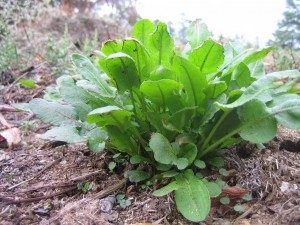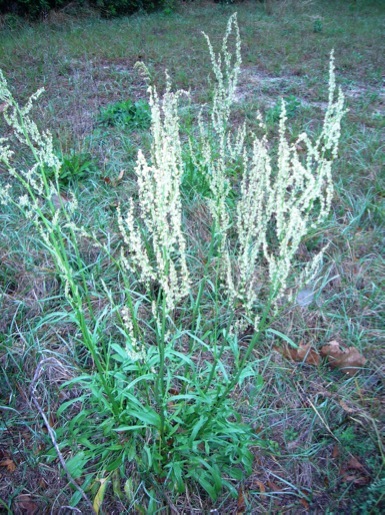Of all the Rumex that grow in the South, Rumex hastatulus is probably the most pleasing. The tart-tasting intensely green leaves are hard to misidentify — edible wise — and the bloom that turns from white to red is pleasing to the eye. Its nickname is the Heartwing Sorrel, describing the mature reddish, winged seed pods.
Because of the leaf shape though, the R. hastatulus is sometimes confused with the also edible Rumex acetosella. R. hastatulus has a tap root and reaches two feet high or more. R. acetosella doesn’t have a tap root and is more mat growing rarely getting above 18-inches high. The R. hastatulus has broadly winged seeds, the R. acetosella does not.
Rumexes are also known as Dock. Actually tall Rumex are called dock and short Rumex are called sorrels. There are some 200 species in the genus. The word Rumex (ROO-mecks) was borrowed is from the Dean Latin name for a similar sorrel in Europe. It comes from Rumo which was taken from the Greek word Rufo, meaning to suck. Romans used Rumix leaves like lollipops. Hastatulus (has-TAT-you-lus) is shaped like an arrow or spear and refers to the shape of the leaves. Acetosella is said ah-kee-TOE-sell-uh, or, ah-see-TOE-sell-ah
Rumexes have long been used in salads and as a potherb. I think they are a great stuffing for that fish you just caught. However, they’re best known in a sorrel soup made by the French. Here’s a sorrel soup recipe to serve six from Fernald and Kinsey’s Edible Plants of Eastern North America, 1958 edition, (though several sorrel soups recipes are available on the internet:)
“Wash (a handful of sorrel) and put in a saucepan with a little water (not covered.) Cook slowly for about a half an hour. Put four cups of milk with a small white onion (whole) in a double boiler. Add two teaspoons of butter, and two tablespoons of flower (blended to avoid lumps) to the hot milk. Let stand and add sorrel. Strain, discard the sorrel, season the soup and enjoy.”
Every book on wild foods warns us not to consume too much oxalic acid, but that’s to keep the accursed lawyers happy. ( Shakespeare was right.) It is true that folks with kidney stones, gout and the like should not over-consume oxalic acid. Yet, when was the last time you read or heard of such a warning for tea, parsley, rhubarb, carambolas, spinach, chard, beets, cocoa, chocolate, nuts, berries, black pepper and beans? They all have oxalic acid as well, but no dire warnings are given with them. The French are not succumbing from sorrel soup slurping. As my Greek ancestors used to say some 3,000 years ago, μέτρον άριστον, [ME-tron A-ri-ston] all things in moderation.
The word “sorrel” is from the High German word sur, meaning sour. Oxalic is from Greek — oksinos, όξινος — and also means sour, and the rumex is mildly tangy because of …oxalic acid… now there’s a surprise. They are refreshing to nibble on, are nice additions to salads. Their tart flavor is both positive and negative. A little is good, but a lot when eaten uncooked, to excess, can leach some calcium out of your bones. (Yes, you would have to consume it like a force-fed lab rat for months, but it can happen.) Rumex, by the way, is in the buckwheat family. Lastly, research on Rumex induratus shows it has antioxidant properties. Let’s hope it runs in the family.
Green Deane’s “Itemized” Plant Profile

Rumex pulcher, native of Europe found through much of the east of the United States west to Texas. Look for hairy stems. Leaves and seeds are edible.
IDENTIFICATION: Moderate plant with white to greenish flowers on a long stalk. Young leaves shaped like a fat sword with hilt, older leaves long and lance-shaped, edges wavy. Great variety, your local rumex may look very different. Get proper identification. R. Hastatulus is a winter annual in Florida. However, I have seen it occasionally in late spring and early fall.
TIME OF YEAR: In February in Florida, springtime elsewhere, can overwinter evergreen in warmer states, can last into summer. It ranges from Central Florida north to New England, west to New Mexico and Montana.
ENVIRONMENT: Old pastures, roadsides, sandy areas, can tolerate a dry conditions.
METHOD OF PREPARATION: Leaves in salad, or made into soup. See recipe. If you cook any Rumex best to use a glass or ceramic pot. Like all plants with oxalic acid should be used in moderation. Some people may be allergic to it.
HERB BLURB
A nettle sting is painful because the sting contains acid. Rubbing the sting with a sorrel leaf or any of the docks/rumex can relieve the pain because they contain an alkali that will neutralize the acid and reduces the sting. The same leaves work well on bees and ants stings but soap or bicarbonate of soda are better, if you have either. Sorrel will not work against wasp stings because they contain an alkali. To neutralize those you need an acid such as vinegar, citric acid, pickle juice even tomato juice.





